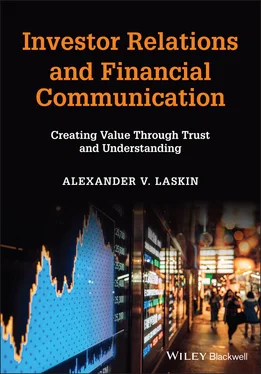The two remaining terms in the definition of investor relations are “strategic” and “management.” The strategic part of investor relations refers to the proactive nature of the profession. Investor relations is not just reacting in response to the outside world – to the request for information from shareholders, for example. Instead, IROs set goals and objectives, and develop a plan for how to reach these goals. For some companies, IROs may set a goal to increase the financial analyst coverage of the company stock and they would work proactively to identify financial analysts who cover similar companies or companies in the same industry and reach out to them to generate interest. In another case, IROs may set a goal of influencing the company’s shareholders mix – for example, they may try to increase the number of retail shareholders, and would develop a plan for how to achieve this target.
Of course, these investor relations goals and objectives must benefit the company as a whole – all these decisions are rooted in the overall corporate strategic vision. This makes it essential for IROs to be part of the top management and to have a seat at the proverbial table where the top-level discussions are happening. This is where the term “management” comes from. IROs are part of the top management team of a company. It would be virtually impossible to be successful as an IRO without having access to the executive C-suite , also called the dominant coalition – people who run the company. It is important for IROs to be well versed in short- and long-term corporate strategy in order to be able to educate investors on the short- and long-term corporate value. It is also important for IROs to be able to relay investor feedback to the C-suite directly and in a timely fashion. All this makes access to the C-suite a must. There is also another way to look at the concept of management responsibility in the definition of investor relations. The term management also means a certain autonomy and ability to control its own domain. IROs are recognized as having an expertise in the investor relations tasks and thus they have a certain autonomy over managing these tasks. They have an autonomy over how to better communicate with financial analysts or how to better relay negative news to the market, for example. This expertise is recognized and appreciated. This autonomy is not absolute – almost every task in a corporate world is done within a team. The same is true for many investor relations processes – the legal team, treasury, accounting, marketing, public relations, and other departments often get involved – but each is recognized as having their unique perspective and their unique expertise.
This is the meaning of NIRI’s definition of investor relations. It is, of course, not the only professional organization and it is not the only definition. For example, IR Society , the professional organization for investor relations in the UK, has a slightly different definition: “Investor relations is the communication of information and insight between a company and the investment community. This process enables a full appreciation of the company’s business activities, strategy and prospects and allows the market to make an informed judgement about the fair value and appropriate ownership of a company.” It is easy to see the parallels between these definitions – fair value is the key goal in both of these definitions. And this fair value is achieved through full appreciation or understanding of the company and what it does. The main process, the main activity of investor relations is communication between a company and the investment community. So, both definitions, although they use different words, basically talk about the same concepts.
These definitions are not set in stone – they evolve with changes in society. For example, several books on investor relations from the 1990s define investor relations as aimed at increasing the share price instead of aimed at fair value. Even the definition of investor relations that NIRI used in the 1990s calls it a marketing function aimed at creating a positive impact on the company’s value. Thus, to better understand the profession it is important to take a glance at its history.
Financial communication, as a function of communicating financial information, has existed since the emergence of finance – if there was money, it was important to communicate about it. In fact, one of the oldest surviving documents of human civilization, The Code of Hammurabi, a Babylonian code of laws of ancient Mesopotamia, dating back to about 1745 bce, has references to such key concepts of financial communication as minimum wage, interest rates, contractual obligations, and inheritance rules.
Investor relations, however, developed later as it is inextricably connected with the separation of ownership and management. In the past, when blacksmiths or other craftsmen conducted their business they did not need to communicate their financial information or build relationships with investors because they financed themselves. They were investors, managers, and employees of their enterprises. As the industries progressed, they started hiring more employees, but the original investors were typically the managers themselves. There was still no separation between ownership and management.
At some point, instead of one manager, it became more common to see a family – fathers, sons, uncles, mothers, daughters, aunts, and so on – as investors and managers of family businesses, which started to replace singular craftsmen. But still family relations were used instead of investor relations in such family enterprises. Finally, the demands of the human enterprises became larger than one person or even one family could satisfy. It required pulling resources together from many different individuals. It was the time for many people to come together and contribute a share of resources to the overall organization – hence the birth of a shareholding company.
It is fitting that the first shareholding company is alleged to be a mining operation. Extracting resources from the earth is a massive undertaking that indeed requires efforts and resources of many people to come together. The copper mine in the Swedish town of Falun is believed to have been operational since the year 1000 based on archeological studies in the area (Rydberg, 1979). However, the first official document of the Stora Kopparberg Bergslags Aktiebolag, a corporation responsible for mining the Falun mine, dates back to June 16, 1288, when 12.5% of Stora Kopparberg shares were sold (Figure 1.1). Thus, we can say that the history of shareholding companies dates back to the thirteenth century.

Figure 1.1 The oldest share: Stora Kopparberg original share, June 16, 1288. Source: Archives of Sweden.
In 1347, as the largest copper supplier in Europe, the company was granted a charter by King Magnus Eriksson “setting up a corporation of master miners” (Anon., 1963, p. 98). The company is still in operation today with 2019 sales of over €10.1 billion. It is still a shareholding company with shares traded at the Stockholm and Helsinki stock exchanges. It employs about 26,000 people in 30 countries and its focus has shifted from copper to “renewable solutions in packaging, biomaterials, wooden constructions and paper on global markets” (Stora Enso, n.d.).
Although Stora Kopparberg is the first example of a shareholding corporation, initially it was not a publicly traded company. In other words, not anyone could purchase a share in Stora Kopparberg. In fact, the shares were reserved for either professional miners or noble people of the area – people whose contributions were essential for the mine to operate. On the other hand, the first publicly traded company, where shares could be purchased by anybody who was willing to pay the price, is believed to be the Dutch East India Company. The company, founded in 1602 for the primary purpose of trading between Asia and Europe, is claimed to be not just the first publicly traded company, but also the first multinational corporation. The first publicly traded company also required the first stock exchange: “The Amsterdam bourse was founded in September 1602 within six months of the company’s formation [Dutch East India Company] and was an integral component to its success” (Chambers, 2006, p. 1).
Читать дальше












